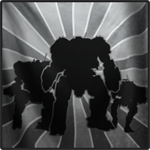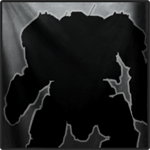Greetings all,
I think you are confusing the lore somewhat. The Mech Warriors neuro helmet only took balance signals from the pilot, and he could override these signals if the pilot needed the Mech to actually be off balance. As in leaning into a punch or heavy impact, even leaning over if needed. Each Mech needed to be "tuned" to the specific pilot, and if the interface was off, it "as some pilots maintained" created a buzz in your head.
There was no direct brain control between the pilot and the Mech, the basic movement was controlled through an advanced computer that moved the Mech in the direction the pilot directed the Mech with the controls. This was "as lore states" why it took years for the pilots to learn how to successfully operate a Mech. See the last reference for movement control.
Ref:
The entire system is controlled by a pilot wearing a
neurohelmet which links the 'Mech's central computer to the pilot's sense of balance and nervous system. Augmented by a combination of throttle, joystick, and dual pedal system, the 'Mech pilot controls the BattleMech like an extension of his own body, comparable to a very large combat suit. Many 'Mechs have fully articulated hands that can be used to climb or grab items.
- The gyro helps establish center-of-mass equilibrium for the BattleMech in a variety of environments.
- However, gyroscopic orientation-sensing and accelerometer feedback is insufficient to maintain control of the 'Mech. Accelerometers and gyroscopes can not distinguish between intentional and hazardous changes in acceleration or direction, for instance the jerk felt when accelerating from standing to running or the sudden change of mass due to a lost limb, respectively. To distinguish between intent and peril, the MechWarrior's own equilibrium is monitored by a
Neurohelmet connected to the gyro's computer. If both the MechWarrior's equilibrium and the balance-sensing mechanisms of the BattleMech agree, the gyro attempts to stabilize the machine
Additional Reference:
The Neurohelmet
The neurohelmet's main job is to enable the MechWarrior to control the balance of the BattleMech. The MechWarrior uses the neurohelmet to tell a 'Mech when and in what direction it should be off balance, and also to help the 'Mech regain its bearings when its balance systems cannot compensate enough for the 'Mechs conditions. The neurohelmet is also used as a part of the security system of a 'Mech. First, a pilot must match the neurohelmet tuning profile, or they most likely will not be able to plot the 'mech. Second, if a pilot does pass the 'Mech's security tests, the 'Mech's computers can use the neurohelmet to scramble a would-be thief’s brains.
Putting Data In
The massive neurohelmets of the succession wars, which sat on the shoulders and inhibited the MechWarriors ability to turn their head, compressed a 360-degree view from external cameras and sensors into a 160-degree HUD display in the helmet with the different firing arcs deliniated and having their own reticules for weapons in those firing arcs. More capable and more modern neurohelmets, such as Clan versions, are smaller and lighter, having large visors and while not requiring the old style HUD display in the helmet. Modern (post 3050) neurohelmets that do not have an internal hud can be modified to display one.
Neurohelmets also have audio systems which generate audible cues, alerting a MechWarrior to threats. Modern Neurohelmets generate these cues in three dimensions, allowing the MechWarrior to quickly locate a threat.
The first Star League did develop some very capable neurohelmets, the best of which were big clunkers used in aerospace fighters. Advanced neurohelmets are capable of providing sensor and balance information from the 'Mechs sensors to the MechWarrior. This "direct neural virtual reality" is very weak, because even the best neurohelmets cannot put enough signal power into the brain to overwhelm the natural biological sensory signals without cooking brain cells. This input limitation is due to the wireless method that neurohelmets use to send information into the brain cells.
Getting Data Out
Getting information out is far easier, being a passive process. The achilles heel of getting complex information out of a brain via a neurohelmet is that the complexity of the human brain, which makes it a hard thing to read. Because of this, neurohelmets "watch" a few specific centers of the brain which are easily translated into commands. The end result of this is an interface that makes it possible for MechWarriors to communicate their basic intentions to their 'Mech more quickly and clearly than speech controls would allow for. This overall process is not quick or smooth, but it does work. For instance, when charging at another mech, the pilot would use the neurohelmet to, at a very visceral low level, command the 'Mech to throw itself off balance towards the targeted mech.
Neurohelmets often include the ability to change communications channels by clenching and unclenching the jaw, or opening the mouth fully.
Fine Tuning
Because of the plasticity of the human brain in order to "watch" and transmit to the appropriate brain centers most neurohelmets have to be fine-tuned to each MechWarrior.
The Outside limits
While the neurohelmet can help translate the MechWarriors basic intentions to the BattleMech and give a small amount of feedback to the MechWarrior, they aren't capable of real-time "mind reading" that would be necessary in order to directly control a battlmechs movements, nor can they input enough data to a MechWarrior to replace the cockpit information systems.
The first Star League could not make helmets capable of this and neither can the Clans.
**
Ref on Movement: **
Moving is yet another task that the BattleMech does a lot of work at. Though a BattleMech may have proportionately large feet, it still must choose every footstep with care in order to compensate for outside forces or in anticipation of environmental features. Again, it is the DI that handles this, via a 'Mechs many sensors. Hand actuators are also tools that the BattleMech will handle via the DI network, especially more modern 'Mechs, which are programmed with very capable and complex actuator routines. BattleMechs will actually move their limbs and torso to avoid collisions. The agile movements of a light BattleMech threading its way through a forest is not only the result of a talented MechWarrior, but the 'Mechs own DI computer avoiding the trees.
However, BattleMechs do sometimes simply crash their way through forests, clip buildings, or trip down into ravines. This is because BattleMechs are programmed to obey their pilots, regardless of the "common sense" programmed into the 'Mech. For instance, a 'Mech will swing its arms through the side of a building if that is what's required to bring weapons to bear on a target. BattleMechs will give collision warnings, but they don't override their pilots. Ironically, this is one of the reasons why it takes a long time to train good MechWarriors. MechWarriors actually have to learn how to think for their 'Mech and exploit the machine's "intelligence" in order to get the results they want.
(Diagnostic Interpretation Computer)
- When a MechWarrior pushes throttle forward, it is the DI that controls the engine power, the gyro, and coordinates actuators.
Ref.
http://www.sarna.net...Mech_Technology
http://www.sarna.net/wiki/BattleMech
TechManual, pp. 34-35
That all sound quite futuristic and set within the BattleTech universe, but current robotic sensors and "brain-machine" interfaces are getting very close to this "story" actually being real. We don't have the Mech's, yet, but there are simpler devices that do work. [ artificial limbs being one.]
9erRed
Edited by 9erRed, 09 March 2014 - 12:48 AM.

 This topic is locked
This topic is locked






















